The Art of Promoting Your App on the Web: Crafting Your Pitch
This excerpt is from the Rough Cuts version of the book and may not represent the final version of this material.
For blogs, the pitch introduces your product. It explains why the blog should devote time and resources to writing about it. In just a few lines, you have to introduce your product and motivate that potential reporting. Sadly, reality doesn’t give you a lot of leeway in terms of getting to the point. You have to grab the blogger’s attention and set up your product’s story in a narrow time window before your email moves from the inbox to the trash bin.
Bloggers want to be sold by your passion. That passion needs to start in the subject line, which is the first thing they see. Your email should explain why bloggers should care and why they should be excited. Think as hard about these press materials as you do about the product itself. You want to create a message that is sharp and polished, and that presents the most compelling story possible about why your product will be interesting to their readership.
In this chapter, you learn about creating pitches that work and how to motivate that excitement.
Designing the Pitch
It’s hard to market well. It is especially hard when you have neither a built-in bully pulpit like your own personal major blog and you don’t have a lot of money to hire a professional marketing firm to get the word out. For most indie devs, that means going to websites and pitching solo, hoping you can sell bloggers on your passion and your product's basic quality. You basically want to tell as many websites as possible why your product is exciting. Unfortunately, many people do this very poorly.
The biggest problem is that you may have spent months, even years, developing this product. You love it. You have put your heart and soul into it, and then you spend two minutes to shoot an email off to a website like ours and your email reads, “Please review my product.”
Here are some real-world review requests we’ve received over the last few weeks:
- Review
- Product review
- Submitting our app for review
- Please review my app
- I need a review
- Potential product review
- Kindle game review request
- Plz review
- App review
- iPhone Application Review
- Submission
- Be rewieved (sic)
When we get several thousand “Please review my product” emails every week, you can guess what’s going to happen—yours will not stand out. There is a skill involved in successful pitching, one that is key to your success. The following section introduces the essential pitch components you need to include in your communication. If you’ve spent all those months working on your product, why are you spending just a few minutes on your pitch?
Essential Pitch Components
A good pitch contains many key ingredients. The secret is to provide all the essential ingredients without overwhelming your reader. Keep your style clean and to the point, but include each and every one of these items in your pitch, especially for software. If you’re pitching hardware, you can adjust your submission accordingly.
A Motivating Subject Line
Subject lines are the elevator pitches of the blogging world. You have to jump in and motivate, define, and sell your product in 80 characters or less. A good subject line communicates the idea of the product and grabs the reader’s attention.
Your subject should say what the product is, what role it plays, and how it differentiates itself from the competition. That may sound like a lot for such a small part of an email, but the subject line is the first thing potential reviewers see. It’s got to get the message out there and establish why someone should care about the rest of the pitch.
Although daunting, it’s possible to do all of this with just a few well-chosen words and phrases. Need some coaching? A full section about creating subject lines follows later in this chapter.
Product Name
Include your full product name, with exactly how you want it to be referred to and with proper spelling. You’d be surprised at how many times people ask us to review something and then forget to tell us its name. They say, “I have got a great video app, would you please review it?” and that’s their entire pitch. Here’s a real world example.
Subject: New iPhone Game
New game released yesterday. Please give it a look. Thanks
Don’t forget the product name! Make sure it’s the proper name, at that. Bloggers need the name that is used on the store, whether it’s the Mac App Store, the iOS App Store, Google’s Play Store, or if you’re selling it through Amazon or whatever. Provide the full name with the proper spelling, capitalization, and punctuation, because that’s what we use for the write-up.
It’s also what we will use online to search for more background and details. We do searches once we get invested in doing a write-up, and the correct name matters. Reducing the hurdles you place in front of your reviewer helps encourage the product to be reviewed and published, especially in a world of tight deadlines where there’s always another (easier) product waiting to meet a writer’s quotas.
Product Price
We focus on iOS and Mac apps at our blogs, so we normally use the price from Apple’s U.S. App Store in dollars. If the product or blog is specific to another region, such as Europe or Asia, specify both the region and the price in its local currency.
You wouldn’t believe how many people forget to include how much a product costs and yet the price is a big part of the product story. If you’re selling something for $39.99 versus $0.99, or $1,599 versus $749, that's telling us a lot about what this item is and its place within the competitive market.
Likewise, if you’re marketing an app, and it is free for limited features but offers in-app purchases of expanded functionality, let bloggers know. Even something as simple as stating “free; in-app purchases available” or referring to your app as subscribing to the “freemium” model are clues to the blogging world that the app is pay-for-play.
We recently covered the Freedom Pop wireless router, which offers free high-speed Internet to consumers. Although its mobile units are “free,” it does require a nearly $100 “deposit” to ensure their return, which becomes nonrefundable after 1 year of use . This kind of non-price pricing is an important part of the cost story, so make sure that you include any financial details about your product that fall beyond the basic buy-then-use scenario.
Links
No matter what product you are selling, you need to include two links in your write-up. These URLs apply across the board. We want to see
A link to your product’s homepage on your own website. This may be an informational write-up page, such as http://mycompany.com/myproduct.aspx or a primary product-related website http://myproduct.com.
A product purchase page, such as your own storefront/Buy Now, an Amazon listing, an App Store listing, and so forth.
The website link supports the blog write-up, allowing reviewers to read your app descriptions, find answers to FAQs, and more. The product purchase page appears in-article to provide a link for interested customers who want to place an order or download your app.
These URLs provide instant access to information that bloggers need, so they can jump directly there without having to start doing web searches. Be sure to check the links and their destination before sending your pitch; bloggers aren’t fond of clicking links and being sent to a missing or incomplete web page (see Figure 3-1).
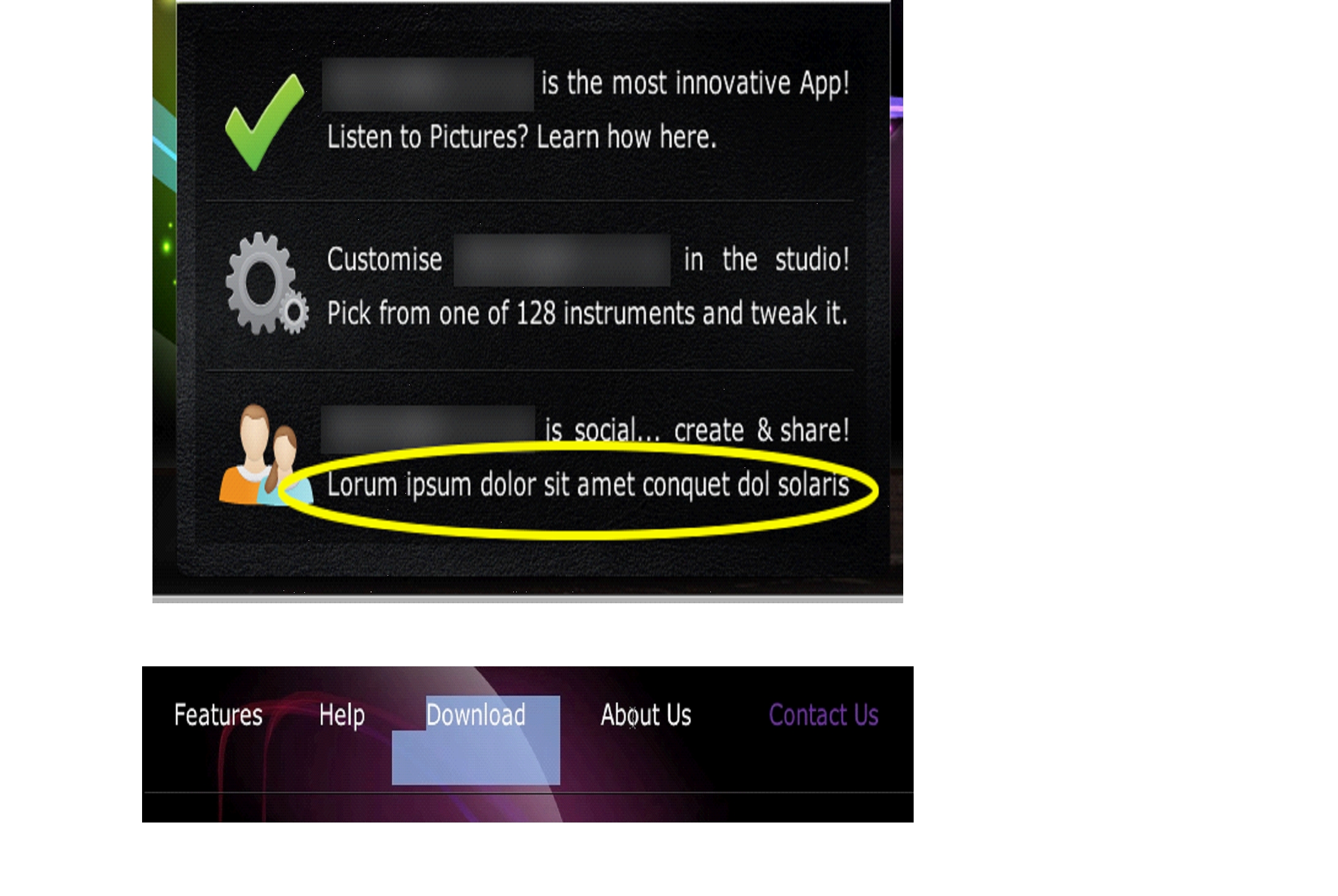
Figure 3-1 Placeholder text and nonfunctional links drive bloggers crazy when they’re trying to prepare a write-up on short deadlines. Try to get your website up and running so the reviewer covering your product can do his or her research at your site.
Screenshots
Although you can include one or two screenshots in your email, do not overwhelm the reviewer with images. There’s nothing quite like receiving a message that bombs your mailbox with too many pictures.
Instead, choose shots that highlight and explain your product. If you have more images to offer, provide a link to a press kit on your site. You may want to include pictures of your company's logo and your product at high resolutions as part of that press kit. Remember this: A few images help tell a story; too many of them create sensory overload.
Submit pictures that emphasize a compelling narrative. The left shot in Figure 3-2 showcases how an application uses Apple’s wireless AirPlay service, a major selling point for the app. The right screenshot enumerates the social services the app supports. This latter uses a standard system-supplied sharing screen and falls into the category of “we’ve seen that” for anyone familiar with Apple’s iOS world. If you have to choose between the two, always pick the image that offers the greater punch. In this case, the left image tells a much better story than the right. Your pitch would be better served by listing the supported social services rather than wasting one of your precious image slots.
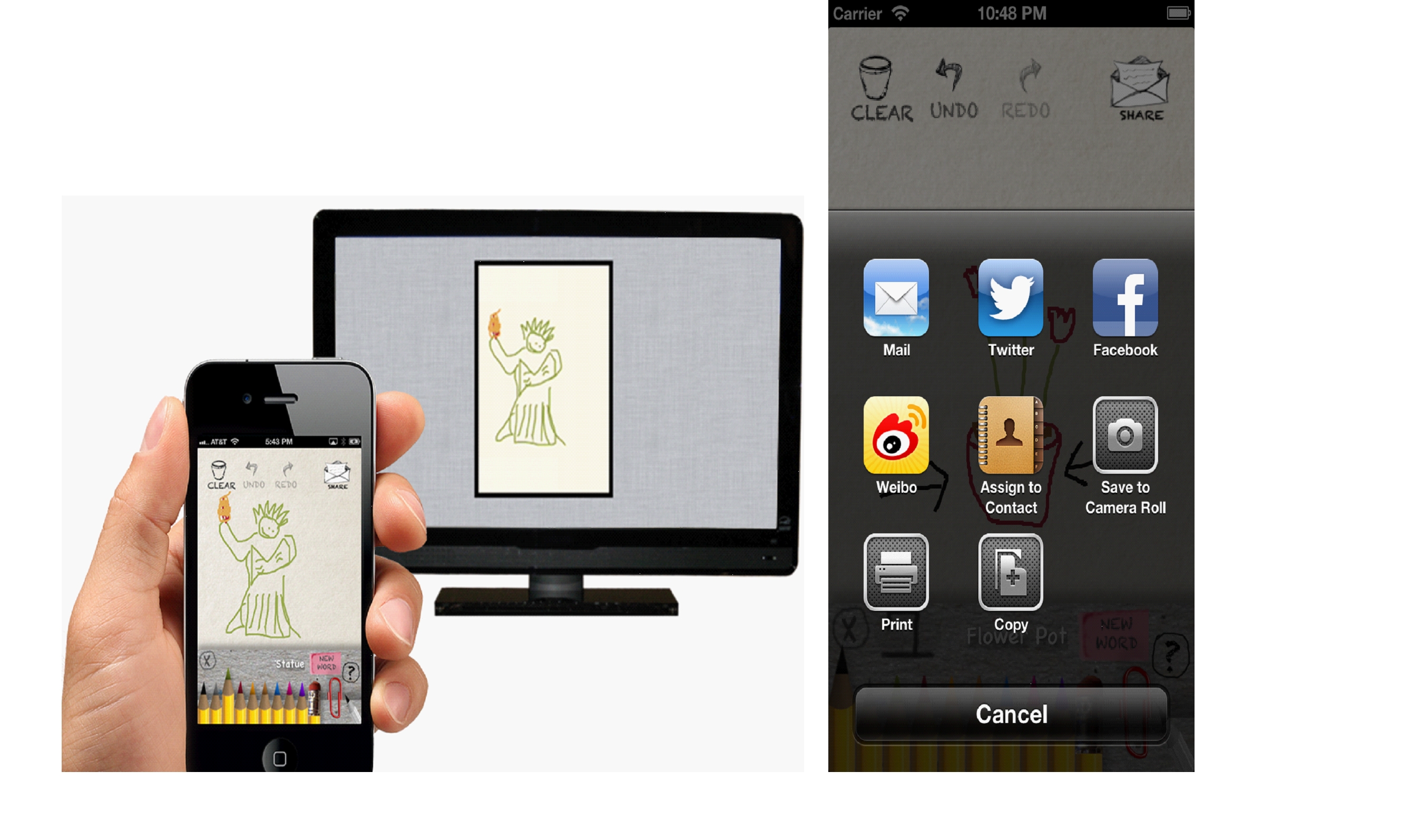
Figure 3-2 Choose your pitch’s product images carefully. Only send one or two pictures, and of those, select images that best showcase your product’s features and GUI. In this example, the left image, with its more novel use case, does a better job telling this app’s story than the right, with its system-supplied components.
Note
Looking to create slicker product shots like the left image in Figure 3-2? The Promotee app ($4.99 for OS X) from Netwalk Apps lets you add screenshots to device templates, including iOS, Mac, and Android platforms.
Video
If a picture’s worth a thousand words, then a video has to be worth at least a million. Videos help showcase your product in a quick, effective way that’s invaluable to bloggers, especially for software. As a rule, always include a product video with your pitch. It need not be professional; it need not be well lit or brilliantly composed. Bloggers just want to see your product in action.
A video provides the quickest way to initially assess your product, letting us know if it's worth investigating further. If your pitch made us curious, your video can take us to the next step: committing to a product review.
We can't tell you how many times people have told us, “We’ll have a video in a week. Do you mind waiting?” Make sure your video (even an amateur one) is ready before you send your pitches.
Here are a few tips about videos:
- Short is okay—A video doesn’t have to be long. In fact, videos should be no longer than 30 seconds to 1 minute in length. Just shoot your product in-action. Thirty seconds plus a screenshot or two tells the story of the app. If you have a game you’re working on, show us the game play. If it’s an app doing time tracking, show us how easy it is to use. If it’s a case, drop the phone. If it’s a portable solar charger, show how it opens, closes, and fits into a backpack.
- Amateur is okay—We do not need or demand professional, well-lit, or well-composed videos. Honestly, we do not care about the glossiness. We just want to see it, and we just want to be able to initially assess the product. This is what tells us, “Is this app worth downloading?” or “Is this accessory worth testing further?” We just want to see what the product is about without having to download it or request a review unit.
- Don’t send the video file—Send us a link to it instead. If you’re worried about privacy, use YouTube’s unpublished video feature, which allows you to set it up so only people you share the URL with can see it. Bloggers won’t share that video unless you tell them it’s okay.
Never underestimate the impact of a video. A short video tells us more about a product than any long-winded pitch description ever can. Use your pitch to convey your product’s importance. Use the video to show us what the product is.
Note
Tips and how-to's for creating effective product videos follow later in this book.
Description
This is the heart of your pitch. Explain in one concise paragraph what your product does and why our readers should care. A good pitch describes and motivates, just like a good subject line, but it does so in greater depth. Explain what your product is, who its audience is, how the product works, and most importantly, what your product offers that sets it apart from the crowd. In essence, differentiate.
This differentiation is what sells your product both to blogs and your customer base. Think carefully as you develop and write these paragraphs. Focus on what your product does better, what it does differently, what it adds, and how it performs. Don’t be wordy: a good description makes its points clearly and then stops before getting into too depth.
When describing what makes your product different, take care when calling out other products specifically by name. Don’t be rude. Use positive well-sourced comparisons to show how your product trailblazes features and provides better service or reliability. If your feature set is truly exceptional, there’s no need to compare it to other less worthy ones. It should shine on its own.
Additional paragraphs can update reviewers on what’s changed since a previous release, plus why those changes were made. As a rule, however, if this information does not really add to the story you expressed in the first paragraph, we recommend skipping this.
TUAW blogger TJ Luoma offers the following recommendation on what makes a perfect software description for him:
First paragraph: Tell us what your app does. I'm amazed at how many people don't do this. Skip the overwrought adjectives about how "unique" and "innovative" your app is. Tell us what it does and why I should care.
Second paragraph: Tell me whatever is new assuming this isn't the first release, in case I tried it once and didn't like it. If it's a new app, tell me why you made it. What need did it fill? How does it change your life? What does it do that other, similar apps don't do?
Third paragraph: Tell me something I'm going to remember about you or the app. If this is your elevator pitch, my floor is approaching and the door is about to open. What do you want me to remember about you and the app?
Feature List
After describing your product, add a short but motivational feature list. Describe those features that make your product sparkle. Use bullet points to explain how your product stands out. These primary selling points should follow your description paragraph.
Try to include 5–7 points that highlight product functionality. Do not overwhelm bloggers with dozens of points. Keep your list focused and relevant. If your app truly is that special, sites will want to find out more after just a few points, which leads to the next part of your pitch.
Contact Information
Specify who you are and how to get back in touch with you. If you do not work directly for the development organization (e.g., you’re sending this as part of a PR firm), make it very clear in the contact portion of your pitch. Your contact information is important to us, because we often need to coordinate with you during the product write-up.
Above all, include a working email address in your reply field. If you say you’re "nope@sorry.com" (it’s happened), bloggers will send your pitch to "notgoingtobe@reviewed.com." Typically, the rule is this: no valid email, no review.
Think we’re kidding? See Figure 3-3. We sadly shake our head when we recall the missed opportunities developers have wasted, not to mention our lost time trying to pursue a review that didn’t have a developer to stand behind it.

Figure 3-3 Use a real e-mail return address. Seriously.
A Sample Pitch
The list of pitch components you have just read through may sound like a huge amount to process. Despite that, each element plays an important role, providing key information. Together, these components aren’t necessarily overlong. You’re looking at about a single printed page of writing, all said. Here’s what a pitch with all these components might look like:
Subject: Collage for iPad offers photo layout fun for parties and business meetings
Having a get-together at lunch, at a conference, or in the board room? Collage provides a quick, easy, and fun way to snap and arrange photos for instant event souvenirs. This app captures images with a single tap and uses the iPad's superb gesture control to rotate, resize, and lay out the pictures exactly the way you want. It takes just seconds to produce a one-of-a-kind collage of your event participants. Collage lets you:
Collage ($2.99, iOS 6 and later) is available for sale now at the iTunes Store (link to iTunes). You can read more about it at my website (link to website). Here is a video of Collage in action: (link to video) and a couple of screenshots follow below. Want more information? Here’s a full press kit for you to explore: (link to website).
- Add, delete, and reshoot images with simple touches.
- Interact with live video feeds in a preview photo that you manipulate.
- Choose from an assortment of background images, including granite, a corkboard, a blackboard, etc.
- Share by email, Twitter, Facebook, and more. Most popular social networks supported.
Please feel free to contact me if you have any questions about the app, if you'd like a promo code for review, or to schedule a time to chat with me or my developers. My contact details follow. Thank you in advance for considering my app for review,
(Your contact info)
Notice each of the key components: a strong subject line, a summary paragraph, a short feature list, pricing, links, and contact information. This may sound like a lot of work, but it takes far less time than it did to develop your application in the first place.
To review, your pitch should contain:
- The exact name of your app, what it does, and why it is different
- The price you will be charging
- One link to your product page on your site and another to its iTunes product page
- One or two screenshots
- A link to a short video
- A concise description that specifies the audience, what the app does, and what sets it apart from the crowd
- Contact information
Remind Us Who You Are
Developers often forget how much information crosses a blogger’s desk. There’s a common error that many companies make, typically categorized as “we presume you have been following our product since birth.” Start each new email thread with a bit of context. If you're replying to an email, that reply creates the context for you.
It is never a bad idea to include a brief product and company bio in your communication, reminding the recipient about your role in the world. If a site has covered your product before, include that, too. The quicker a blogger can come back up to speed on past coverage, the easier it will be to move forward to new events. It never hurts to assume that a blogger suffers from total or partial amnesia about your product and company.
Remember the movie Memento? The one whose leading man had anterograde amnesia? Treat your bloggers as if they were the Guy Pearce character in that movie. You don’t have to tattoo your contact details on the bloggers’ arms (in fact, we recommend against any forced blogger body mods as a rule), but it helps to start off each contact as if you needed to re-establish your existence in their world.
We may have met you at a conference. We may have spent time with you enjoying karaoke and Jello shots. But, there’s still a good chance that when you ping us by email, a medium without faces or voices, that we’ll have absolutely no idea who you are.
Here are a few quick pointers:
- Assume that bloggers suffer from total or partial amnesia about your product and who you are.
- Include a (brief!) company and product bio.
- Include links to past coverage from the site you’re pitching to.
- Remind the site which blogger you worked with in the past.
Tell the blogger about your past interactions. (“Remember me? We were in that bathroom in Cupertino together when you had that stomach bug, and I offered you some Pepto as you were doing the Technicolor fountain.” Or, “You did an amazing write-up of our product AutoFixit Pro last year, and I wanted to follow up about our newest offering.”)
"Tell us who you are and what this product is first. Then, explain what's new and great, and do that in 75% fewer words."
—Victor Agreda, Jr., TUAW Editor-in-Chief
"That's something I've had to put up with at Macworld for the last few years. People who come up and say "Hi. So, what do you think of our newest product?" and I'm looking at them like they're insane, because I have NO idea who the hell they are."
—Anonymous Apple blogger
Capturing Attention Through the Subject Line
Now that we’ve overwhelmed you with the structure of a pitch, it’s time to step back a little, and go into the how’s and why’s in more depth. The next few sections slow down and introduce the pitch subject line in detail. Assuming you’ve hung in here and are now ready to explore these features, here are ways you can best build a subject line to create the greatest effect.
The Subject Line’s Role
Pitching products establishes a relationship between yourself, your product, and the potential reviewer. When you pitch, you typically have just a few seconds to catch a reviewer's eye and make that person care about your product. Sites receive scores of pitches daily, not to mention PR blasts and personal emails. You need to make your pitch stand out. Bloggers want to find that next great app or accessory. A good subject helps them do that.
The very first thing bloggers see in their inbox is your subject line. Your subject introduces your product and explains why reviewers should be excited. A well-written subject gets straight to the point, announces the product, describes what it does, and says who it's for.
Expect your recipient to see no more than the subject line and possibly the first two lines of each email to determine what is worthy of additional attention—in other words, what you see when clicking through the inbox in Apple Mail. That sounds harsh, but when you realize that bloggers can sometimes go through a hundred or more pitches a day, it’s not surprising.
Good Subject Lines
The following list provides good subject-line examples for made-up products. None of these examples are flawless, but they all work effectively. Always remember that perfection is the enemy of good. What you need for your pitch email is a good subject line, one that works to communicate your product’s potential.
- New pirate game "Yar Har Algebra" teaches your kids math on the iPhone
- Ultimate Destroyer for Android blasts your way through outer space with high-powered explosions
- Compresso Plus’s offsite compression reduces monthly data consumption *before* data reaches your computer or mobile device
- Calendar Superhelper: Organize your daily life more efficiently on Windows and OS X
- Watch any video format on your iPad, not just H.264, with Videoify for iPad
- Use your device up to 150% longer with Battery BoosTR’s newly updated external USB power pack.
- Protect your laptop with MiniShield. 100% of the protection, just 30% of the weight
- Jovana’s SuperHUB 2™ powers all your 3.0 devices, adds 10W supercharging ports
These subject lines name the product, specify the platform they run on, and explain exactly what the product does. After looking through these, you know their genres immediately (education, gaming, telecom, etc.). What's more, you get a sense of the app’s audience, be it kids, gamers, or general consumers.
Remember that many sites review apps for more than one platform. It helps to know that the Calendar Superhelper (for example) runs on OS X and Windows, not on iOS or Android. Don’t be afraid of the extra characters. It doesn’t take a lot to specify your app's target device.
Remember these points for good subject lines:
- Good subject lines communicate what a product does.
- They specify who the product is for, both audience and genre.
- They specify the platform that the product runs on.
- They provide a hook as to why a reviewer should be excited.
This last point, the hook, is both the most important and the hardest function to fulfill. It’s a callback to your initial development analysis. There’s a reason your product stands out from the competition. That reason belongs in your pitch subject line. Whether your product is different, better, more flexible, or more fun, your subject line should communicate that excitement.
Why Subject Lines Fail
Subject lines fail when they don't provide the information bloggers need to understand a product’s who, what, and why. Here are examples of pitch subject lines that miss the mark, all adapted from real world examples:
<no subject>—A completely missed opportunity.
Product review or Please review this app—What app is it? For whom? What does it do? These unadorned words in a subject line often cause an involuntary reflex in bloggers that causes the index finger to twitch and hit Delete.
Review our new puzzle game, Battle Snails or Review our FUNKEH tablet case—This is a better subject line, because it tells us what the product is and its name, but it doesn’t explain the motivation, the genre, or the audience. You don’t need to ask us to review your product. It’s implicit in the fact that you’re contacting us that you’re trying to entice us to look at your app or hardware. Use those characters for a better purpose.
Pan-Fried Dumplings Free. Now available for iOS—This names an application and specifies the platform and what it costs, but does little in the way of promoting the software itself. Is it a cooking app? A game? An ebook? Sure, the name is intriguing, but it’s not necessarily a motivation to read the rest of your pitch.
Promo codes for a new app or Review unit available—Everyone loves trying out products, but this subject doesn’t specify what product you’re writing about or any other hook. For apps, there’s a good chance that you just wasted the promo codes you sent. Bloggers see so many offers for app promo codes that they’re just not that much of an enticement as many developers hope.
Each of these subject lines fail because they’re not specific or motivational. Their generic nature means they won't catch a blogger’s eye and make them pay attention. Recall the key rules for good subjects discussed earlier in this chapter. You should
- Name the product.
- Motivate the product with a hook, something designed to catch people’s attention.
- Specify the platform(s) the product works with.
Each of these sample subjects failed to provide one or more of these key points. In doing so, they flopped in explaining their product to bloggers. A pitch that doesn’t make a blogger want to open the email and read about the product in more depth is a failed pitch. Bad subject lines are typified in the following ways:
- Bad pitches don’t explain the who, what, and why of the product.
- Bad pitches are not specific or motivational.
- Bad pitches don’t name the product or specify a platform(s) it’s used with.
- Bad pitches don’t provide a hook.
Note
Always specify your platform even for iOS- or Android-specific sites. This especially holds true when your app only works with phone features (so can’t be used on tablets) or is meant just for some members of the covered computing family.
Subjects for Non-Review Pitches
Many developers think that they only way they can solicit coverage for their products is to solicit a review. They couldn’t be more wrong. Blogs cover lots of stories. Reviews only make up a small portion of those write-ups. Blogs also post about updates, sales, items in the news, and more.
Your subject lines shouldn’t be limited to new review pitches, either. Each of the following subject lines offers a coverage opportunity that goes beyond a simple “review this product” request:
- Blingo for OS X: Best audio editor now supports export to five new formats
- Top-rated Android first person shooter Biffy Goes Wild goes free for Halloween Weekend
- Black Friday Special: Hubitorium offering 25% discount to TUAW readers
- Fan favorite virtual aquarium app Swimmy for iOS acquired by Snippet Games
- MaxiDrive SSD pricing now 20% lower; capacity increased to 800 GB
- Hurricane Lessons: BackupPro and the importance of offsite backups
These provide examples of other real-world situations where you may email a site to promote your product. You might introduce a major update, put your product on sale, or announce a corporate event that affects your title. Sites are often interested in these events as well as items for potential review.
Always try to think of what makes your products or business newsy. If you can tie your app, hardware, or company into a story that could be featured on major blogs, go ahead and pitch it. It may not make the cut, but unless you put it out there as a potential story, it can’t be considered in the first place.
You don’t want to overwhelm bloggers with minutia of your day-to-day business practices, but if you think major app update or personnel changes deserve wider attention, go ahead and put those facts out there through press releases and blog pitches.
Promo Codes
Promotional (promo) codes are a feature that allows you to gift free review copies of intangible products to bloggers (see Figure 3-4). You’ll find these used for books and applications in many stores. We work in the Apple world, so we commonly handle promo codes from the iOS and OS X App Stores, as well as from Apple’s iBookstore. We also occasionally receive Amazon gift certificates and product codes to use at O’Reilly Media, Apress, and other publishers.
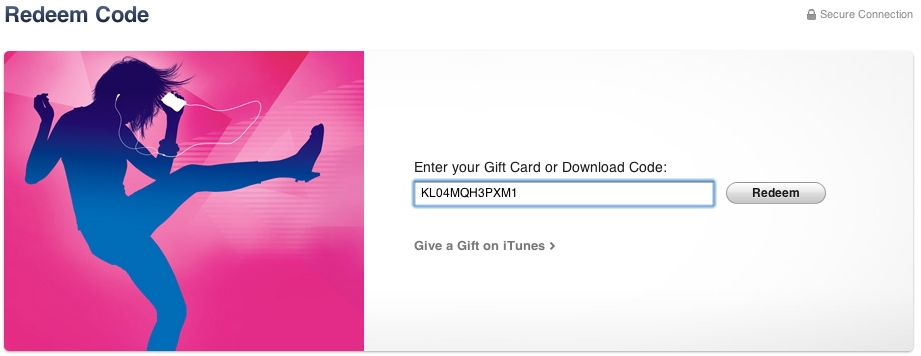
Figure 3-4 Promo codes and gift cards allow reviewers to purchase intangible products for testing.
As a rule, pretty much every website you ask will say, “You don't have to send promo codes.” We will ask for them if we’re interested in looking over your application or book. Apple offers 50 promo codes per app product release. If you update your app, you get 50 more codes. You can also gift applications, paying just 30% of the application price because you receive 70% of the sale back from Apple.
So, should you include promo codes or gift cards in your book or application pitches? We’re going to answer this, but we are not doing so in any official capacity. This is not any website’s policy, and we are not trying to tell you what you must do.
So, what is our answer? It's this: Don’t bother sending unsolicited gift cards. We’ll return them or toss the email without seeing the redemption code, and you’ll be out of some money. Promo codes are a different matter. We understand that Apple developers and authors receive 50 units for free.
We believe if you are a relatively unknown developer, you’d be foolish not to include a promo code for your application with your pitch. That promo code helps you leverage what we can only call “blogger curiosity”. Offering a promo code opens the door to a blogger’s impulse to try out new things.
Bloggers often cash in promo codes just to see what the app is like. If they have time to play around and the app sounds even the slightest bit interesting, they may simply throw the code into iTunes to see if there's anything worthwhile there.
These are the same bloggers who will likely not write back because they don’t want to waste one of your promo codes and don’t want to promise you a review. Remember. We’re human. We feel awkward asking for things, especially when we can’t make you any promises about using it. Including promo codes help you skip the bit where the blogger has to write back. You offer the code, you give them the option of using it or not using it, and the story ends there.
In our experience, a promo code doesn’t guarantee anything. It just opens the door ever-so-slightly wider, making it easier for the blogger to look at your app. Anything that removes obstacles between the blogger and the actual app experience will serve your interests.
Yes, the promo code may go stale. And yes, the blogger may download your app and then a few weeks or months later delete it without ever actually using your app, but this is a better chance at a review than having your pitch immediately go into the “meh” pile.
Do not include a promo code because you must or you ought; do it out of self-interest. Do it because it helps increase your odds, however small, for that all-important review.
Note
All promo codes have an expiration date and can only be used before that date, four weeks after the date of issue. Apple promo codes are available for Mac and iOS applications and iBooks. You must enter into a separate Promo Code agreement with Apple when you place your request. You may request a maximum of 50 codes per app version or book release.
How to Send Promo Codes
The simplest way to share a promo code with a blogger is to paste it directly into an email. If you know the date the code was created and when it will expire, add that information as it is valuable to the recipient (e.g., issued 4/05, expires 5/05).
That’s because bloggers often return to older pitches they marked for later review. Knowing if a promo code is still valid removes obstacles on the path to their redemption. This is particularly valuable information when bloggers decide whether to investigate further and need to weigh how much work will be involved.
Some developers choose to send a redemption link instead of a basic promo code. Links allow reviewers to click-and-redeem as a single action. (This is great when the redemption request works, and not so great if it doesn’t.) We recommend always including the actual code along with the link as a procedural backup.
A basic redemption link looks like the following, with the actual code appended to the end instead of the words “promocode.” This link opens in a web browser and then redirects redemption to iTunes:
https://phobos.apple.com/WebObjects/MZFinance.woa/wa/freeProductCodeWizard?code=promocode
If you have the skills, you can create a more indirect link that goes through a website, issues a promo code, and tracks its redemption. Although still relatively rare, some of the vendors we work with have started doing this as a way of better monitoring code use. (How-to is left as an exercise for the reader.)
Creating a Product Link
In the Apple world, it's easy to copy an iTunes link. Right-click the app icon and choose Copy Link from the pop-up. The link is saved to the system clipboard, ready to be pasted into your pitch email. For Google Play, just right-click and copy the link from your favorite browser. (See Figure 3-5.)
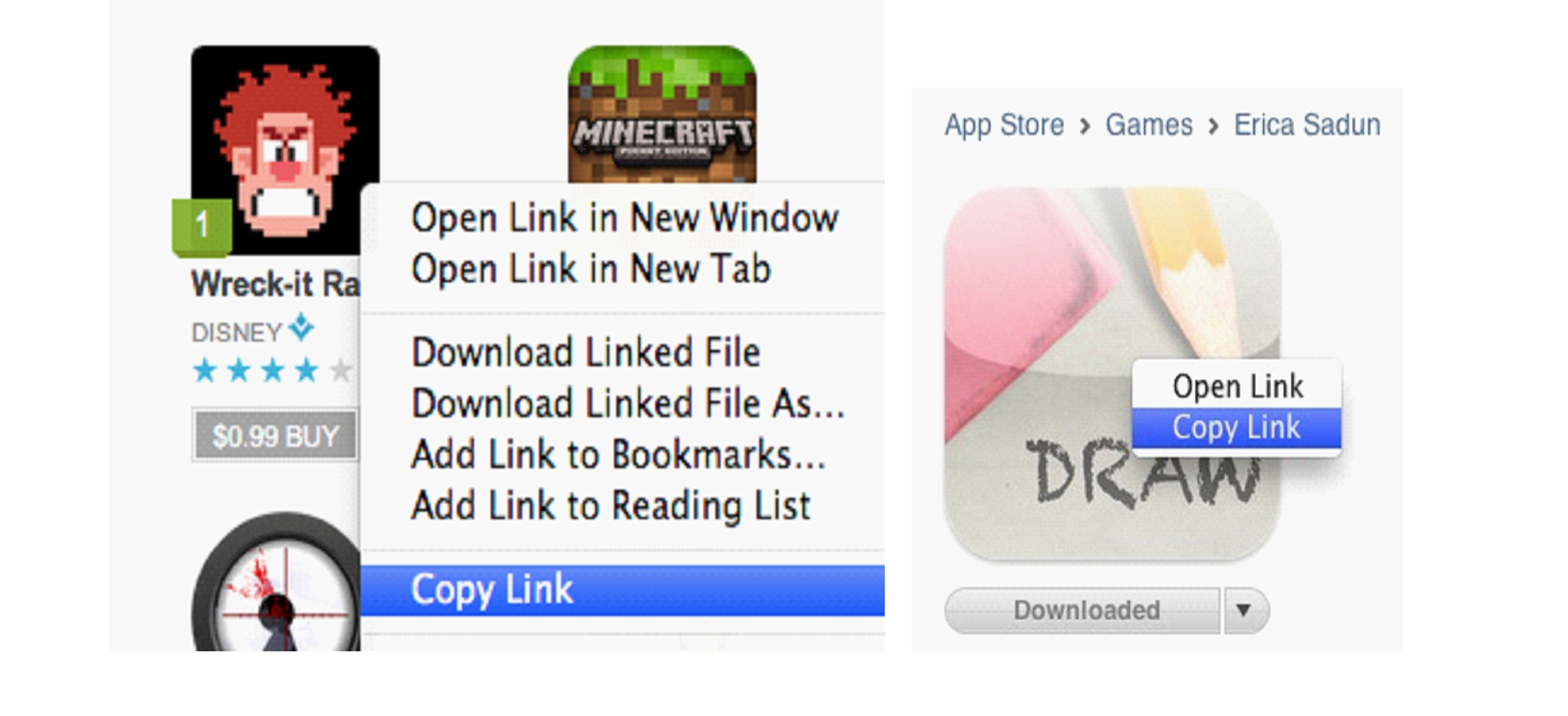
Figure 3-5 Copying product links for your pitches.
For developers with products in the Amazon App Store, open your app’s page in the store. In your browser’s address bar is a long form address that looks like this:
Delete all of the information after the last forward slash and you get a much more manageable URL that still works perfectly:
http://www.amazon.com/Imangi-Studios-LLC-Temple-Run/dp/B00B2V66VS/
Creating a Company Link
You can also create company links for your app-related communications. These links point to all of your company's products in a store, not just individual apps. In the Google Play store, click the developer’s name, and then copy the company-specific URL (for example https://play.google.com/store/apps/developer?id=Disney).
Because Apple does commerce through iTunes rather than the web, it offers an interactive web tool to help with this. To create an “artist link,” as these are called, point your browser to itunes.apple.com/linkmaker and enter your company name in the Search field (see Figure 3-6, left). Set the country and Media Type and click Search.
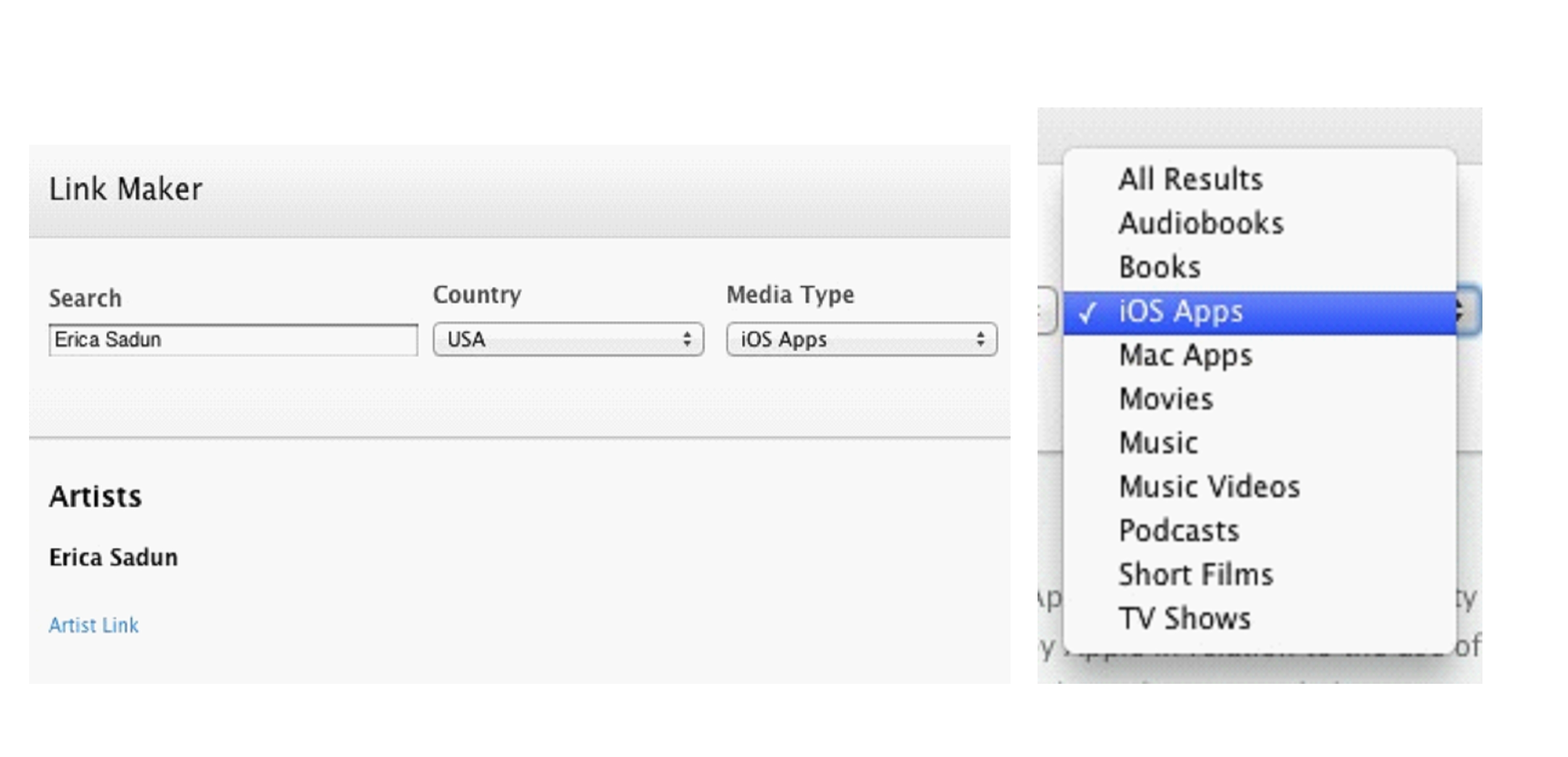
Figure 3-6 Link Maker is found at http://itunes.apple.com/linkmaker.
The newly generated link appears below as Artist Link, along with a list of the apps found in the requested country store that match your search term. Right-click and copy the link to your system clipboard (see Figure 3-6, right). Erica's artist link is itunes.apple.com/us/artist/erica-sadun/id282772077.
You can use this link maker to create artist links for the iOS app store, the Mac store, and iBooks. Because links are generated on a country-by-country basis, you'll usually want to make sure the link you send matches the home country of the blog you're communicating with.
A Genre/Category option on the Link Maker page lets you limit searches to Games, Utilities, and other categories. Use this option when you have a lot of content on the store and want to narrow the search results to a specific product type.
Tokens for Mac
For iOS and OS X developers, we recommend Tokens for Mac ($29, usetokens.com). It helps you track and manage your available promo codes. Keeping on top of your promo codes can be a hassle. Most developers end up with text files by the dozen or complicated spreadsheets. You want to know when items were issued (they expire in four weeks), who they were shared with (so you can follow up with potential reviewers), and how many remain so you can manage the 50 codes allocated for each app revision.
Tokens for Mac simplifies the process of managing promo codes. With it, you can generate trackable codes that ping you when they're redeemed. To start using the software, just sign in to iTunes Connect. From there, Tokens takes over and manages the process of contacting Apple and retrieving product info. Because the app is basically scraping the App Store, its use falls outside the Mac App Store guidelines. You need to purchase the utility directly from the developer.
Tokens starts by showing you a list of all your apps once you've signed in. You immediately see the remaining available promo code slots, which are shown as "available." (See Figure 3-7, left.) Upon choosing a code to redeem, Tokens requests it from iTunes, signs the contracts for you (a convenience I find amusing, which you may too if you think about it for a few seconds), and downloads the code. You're now ready to share it.
To share, Tokens creates an interactive webpage link (see Figure 3-7, right) that tracks redemption and offers a one-click solution for reviewers.
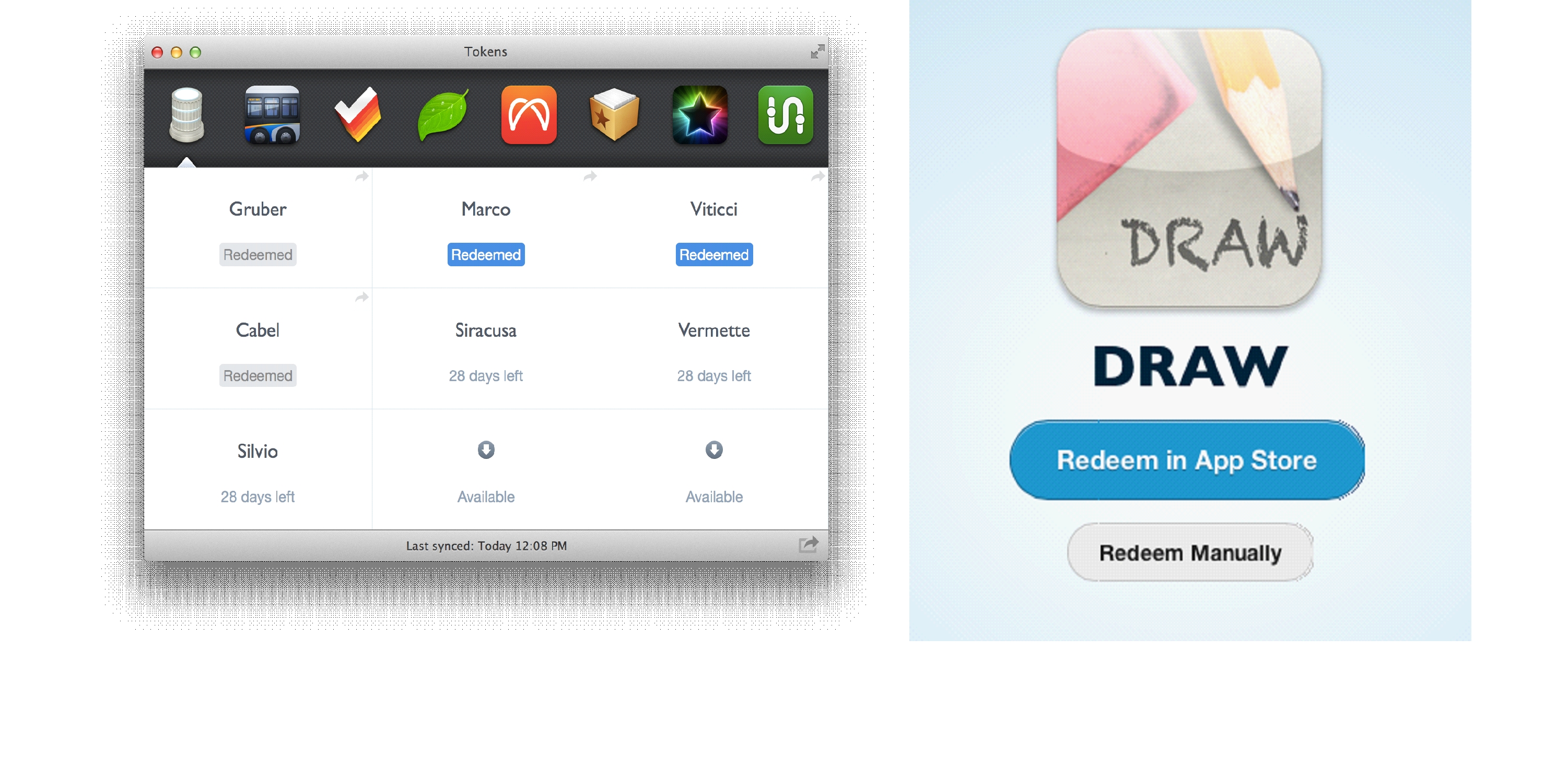
Figure 3-7 Tokens for Mac helps iOS and OS X developers manage their promo codes.
Going Free
If you’re an application developer in the Apple ecosystem, you may want to consider an alternative to those 50 promo codes. Instead of using up codes at launch, consider making your app free for a while. It's a great way to allow reviewers to download your app without restriction and create some buzz, all at once.
A free promotional period can drive your launch, building momentum as the app first debuts. This same approach can be used with books at Amazon, through Amazon’s exclusive KDP Select program. You can select up to 5 free days every 3 months.
Free’s not just about launch, however. Going free provides a way to give your app a “second chance” at reviews it may have missed out on during your initial release.
Any short free period helps promote your product by raising its rank and visibility in its store. Your goal is to create enough awareness that word-of-mouth and rankings will help propel sales once the product returns to its paid status.
Hi there. I just wanted to let you know that [Product Name], the addictive puzzle game for iPhone and iPad is free for the next couple days. We are currently ranked in the top 25 of puzzle apps and top 10 of trivia apps and rising. I'd love to get a mention on your website. We were mentioned on both Engadget.com and Appadvice.com today. Our link is itunes.com/apps/productname.
THANK YOU,
James
Differences Between Hardware and Software Pitches
As the hardware editor for TUAW, Steve not only sees various PR blasts for software, but he’s also the recipient of hundreds of emails touting the latest cases, hard drives, styluses, microphones, and other products for Apple gear.
In many ways, it’s easier for someone to write a hardware pitch, because there are usually physical or performance parameters that make one product stand out over another. There are also non-measurable criteria that make certain products worth reviewing, most dealing with new hardware categories (spudgers, anyone?) or outstanding design.
Most of the focus in hardware reviews goes toward three criteria: design, value, and functionality. Highlight these focus points in any pitch you create to excite bloggers about reviewing your device.
Design
For many accessory items, design represents one of the key features that differentiate your product from the competition. For example, Steve receives a lot of iPad cases to review. Just looking around his office at this point in time, you can see 13 different cases, most of which look remarkably alike.
If your product looks more stylish than the rest, point that out in your pitch. One of the most memorable iPad cases Steve has ever reviewed wasn’t that hot in terms of build quality or functionality, but it did have an amazing cartoon-like design on the outside (see Figure 3-8). That resonated with Steve’s childlike 55 year-old mind, and it got attention where a more mundane and businesslike case would have gone right into the email trashcan.
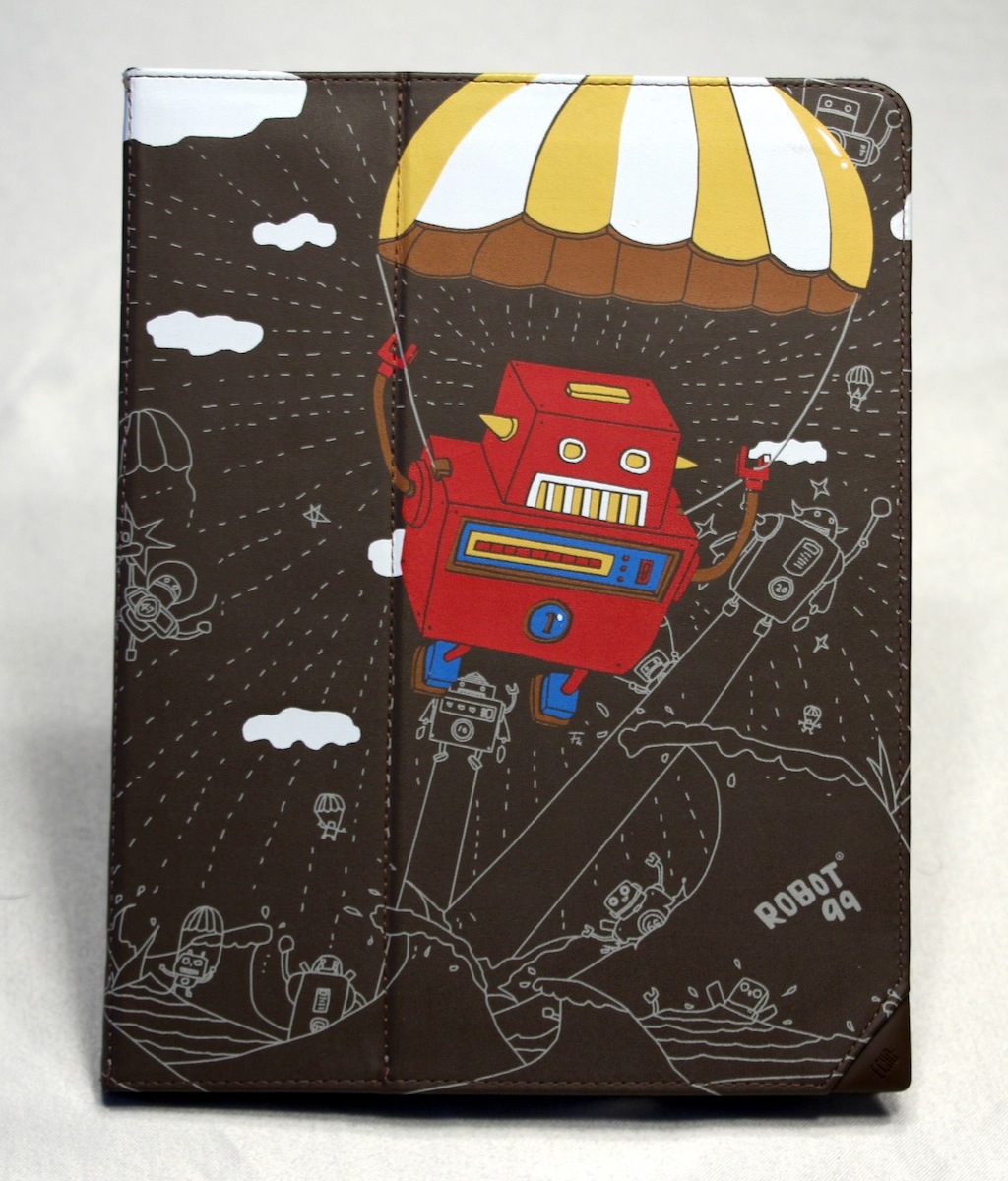
Figure 3-8 A beautiful iPad case.
One “me too” product that is pitched to TUAW on a way-too-frequent basis is the iPad keyboard case. Most of them are way too thick, have lousy keyboards, or, sadly, both.
When accessory manufacturer Logitech shipped one that was not only incredibly thin but was also touted by other reviewers as having a great keyboard feel, Steve got excited and asked Logitech’s PR firm for a review unit. The keyboard cover that arrived in a few days did not disappoint. Steve’s review reflected his excitement about how it looked and worked. That’s what good design will do for a blogger.
Know your potential audience, too. At TUAW, we focus on Apple products, so we know what excites our readers. Steve has written reviews for clear polycarbonate desk mounts for the Mac mini, simply because of the unique design and its application to an Apple device. A major external disk-drive manufacturer got a good review from TUAW for a disk drive that is specifically designed as a perfect companion for a present-day Apple iMac. Once again, a design feature made just enough difference for me to consider the drive worth writing about.
Value
We’ve mentioned the importance of value to blog readers elsewhere in this book, and it is equally important when discussing hardware and accessories. Value doesn’t necessarily mean “cheap;” it does mean that the product provides more bang for the buck in terms of design or functionality than its competitors.
Value is represented by emotional reception to a product compared to its price. Your product has to deliver something that's worth at least—and hopefully more—than its sticker price, at least in the customer's perception.
Potential customers want value, especially in times of economic hardship. It’s important when you’re selling a 99¢ app; it’s absolutely crucial when you’re trying to get a customer to buy a $99 iPad case.
The words “solid,” “well-built,” and “useful” all speak to how people perceive value. Customers will pay more for better quality, but they want to feel they've paid a fair price in return. That trade-off between cost and utility is how we evaluate value for our readers.
Functionality
One key criterion Steve uses to make the decision of whether or not to write about a new piece of hardware is functionality. Does the hardware or accessory provide a new function that hasn’t been available up until now? Does it make performing a specific function easier to accomplish? Does it do it faster, with less user involvement? Are fewer cables involved, or can the new hardware provide wired capability over radio frequencies? Is it more energy efficient, or does it use a form of renewable energy?
The functionality of a hardware product is so important that a manufacturer who is pitching a product must first talk about function. An example of how functionality can get your foot in the door at a blog came up soon after the third-generation iPad showed up. There was talk about how the higher amperage requirements for charging made some third-party charging cables and accessories unusable with the new iPad. One manufacturer pinged Steve with a pitch about an in-car charger that could actually charge two of the third-generation iPads at the same time, so he jumped on doing a review.
The moral? Be aware of issues that are occurring in the marketplace, and if your product is able to surmount those issues, you’ve got a great pitch for a story.
Hardware Pricing
There is one more thing to remember about hardware reviews: Not only are they much more likely to be written, but there aren’t as many hardware products as there are apps, and they are much more apt to receive attention from blog readers. It’s not uncommon for someone to drop a buck or two on an app that looks interesting, only to toss the app after trying it out. The situation is different when a person can be looking at spending a significant amount of money on a hardware purchase.
Particularly for very expensive hardware that you’re pitching to bloggers, be sure to give them some compelling reasons why people should buy your accessory or equipment. When bloggers have seen a bunch of sub-$100 iPad keyboard cases, tell them what makes your $199 case special enough to merit spending twice the amount of money to purchase it. They’re not the only people who want to know; the readers are going to question equipment that seems to offer similar functionality at a much higher price. By “question,” we mean that they’re going to question your sanity and motives in the comments on the blog.
Note
With accessories, never forget what percentage of purchase price your hardware represents. Our readers are well aware that a $100 keyboard for a $400 tablet accounts for a 25% boost in monetary investment.
Video Gold
If there’s one suggestion we can make to those who are pitching a physical product to bloggers, it’s to make sure that you have a product video. In some cases, it helps clarify some questions that the blogger has about your product, but for the most part, it’s there to show all the physical attributes of your product before you actually send out review hardware.
It doesn’t take much skill, time, or money to create an effective marketing video. We’ve been sent videos that were shot and edited on an iPhone using iMovie for iOS, and they’ve been tremendously effective. Stock music and titles can tell the story faster and more professionally than a bad voiceover, so don’t think that you need to hire a voice actor or record your own voice.
As with apps, marketing videos help us understand the product quickly and see how they're used in the real world. Keep the video short (30–60 seconds is ideal), keep your camera in focus, and remember that you're trying to communicate and sell. Share the ways your product can be used in real life.
For a good idea of what to do and not do with product videos, think of some of your favorite tech products and then see if you can find manufacturer videos out on YouTube. Watch a few of them, and take notes on which ones you like and those that turn you off. It doesn’t take a lot of time to do this, and a little bit of homework can help you learn how to make an effective product video.
Hardware Review Logistics
Hardware is generally more expensive than the average app, so when a blogger asks for review equipment, he or she usually plans to write about it. Due to the expense involved in shipping hardware, don’t send it to the blogger unsolicited. If we decide not to write a review, you’re not only going to be out the cost of the hardware, but you’ll also pay for the shipping.
For really expensive equipment, like RAID arrays or computer equipment, be sure to ask the blogger to return the equipment. In a case like this, it is generally accepted practice to include a return shipping label and a cover letter letting the blogger know that he or she needs to return the equipment within a certain time period.
Steve had a personally embarrassing situation occur one time where a manufacturer sent an interesting accessory for a review, but said nothing about returning the accessory when he was done with it. After several months, he included it in a box full of giveaway equipment that was sent to New York City for a TUAW meetup. About a month after the meetup, Steve received an email from the manufacturer asking when he’d be sending back the accessory. That was awkward, to say the least.
Most reputable blogs refuse to keep the review hardware, instead offering it to readers in giveaways or donating it to worthwhile causes. Why? Blogs do not want to create the appearance of exchanging reviews for payment of any kind. Providing review hardware as a giveaway item for a blog is a great way to build goodwill not only with bloggers, but to also get readers excited about your product.
There are some exceptions to the giveaway rule, however. Examples include earbuds that become encrusted with blogger earwax during review (something that is unsanitary, rather disgusting, and actually quite common), clothing items, or items that become damaged during the review.
If you want reviewers to return cables, specially designed twist-ties (not a joke), and other smaller pieces, make it clear in the letter to the reviewer that you place in the box along with the product. Many companies request only the return of the primary item, assuming it will be completely cleaned up and repackaged for the next reviewer so it arrives pristinely as the manufacturer ships it.
During unboxing, it’s common for small items to be lost and the packaging to be destroyed. If these items are important to you, state so explicitly. We’ve had incidents where panicked PR representatives have contacted us asking, “Where’s the tiny microphone that was included in the packaging” that we missed entirely and that was accidentally tossed with other post-review paraphernalia, such as packing pellets, warranty cards, and so forth.
Especially for larger items, it’s generally courteous to include a return-shipping label along with re-packaging instructions to make it easier for reviewers to return your equipment after the review. Most sites can ship items back on their own dime, but they’d prefer not to.
Benchmarks
When you send hardware to a blogger that can be physically compared to other competing products, expect that the hardware is going to be benchmarked against similar equipment. Receiving benchmark information from companies is rather suspect; Steve would rather perform his own tests and comparisons instead of relying on numbers provided by manufacturers. On the other hand, if you can provide bloggers with benchmarks from an independent tester, that is definitely acceptable.
Note that bloggers can run into issues when performing their own benchmark tests. Steve ran a series of tests on a portable RAID array from a reputable manufacturer and found that the array ran slower as a RAID 0 striped set than as a RAID 1 mirrored set—something completely contrary to what should normally happen. He noted that discrepancy in his review and almost immediately received concerned feedback from the manufacturer, who pointed out that other benchmarking software showed proper results and that his computer’s FireWire 800 port might be faulty. Needless to say, Steve updated the review with the manufacturer’s comments and began looking for another way to test FireWire drives.
Other benchmarks rely on more subjective tests. When asked to review headphones, earphones, or speakers, Steve always prefaces his comments with a note stating that the sound quality he writes about might be affected by personal listening preferences. Anyone providing sound equipment to reviewers might want to include more objective evidence, such as frequency response charts or reviews from audiophile magazines.
Note
During reviews of headsets, speaker phone docks or telephony software, for example, we may place calls to other bloggers on our team to hear their (subjective) feedback about audio quality. We try to include their comments about crackling, clipping, lags, and other unwanted effects into our write-ups.
A Word About Kickstarter
Creating hardware can take a lot of time and money. For something as simple as a phone or tablet case, a manufacturer may need to pay for CAD assistance, 3D printing to make a usable prototype, development of a master mold, and more. All that work burns cash, which is why a lot of folks working on hardware projects are looking for funding on Kickstarter (http://kickstarter.com).
Kickstarter is a wonderful way to do three things: get out the word about your potential product, get funding to pay for development of the product, and weed out product ideas that aren’t going to be successful.
As a result, bloggers receive a lot of pitches for Kickstarter projects. Although this is a great way to excite potential customers about your future plans for a product, you also have to sell a blogger on writing a post about a product that may or may not make it to market. That’s even tougher than getting them to write about a product that’s ready to sell.
Here are a few suggestions about pitching Kickstarter projects:
- Don’t try to get bloggers involved unless it appears that your project is actually going to be funded by the deadline date.
- Don’t create a desperation bid to get publicity if you have a week to go and your project is only 25% funded.
- Don’t call or write us with amazing stories about your new product idea that hasn’t even been accepted by Kickstarter.
- Don’t ask all of your friends and colleagues to write us to kick off a fake "grass roots" campaign for your Kickstarter project.
Finally, remember this: Bloggers are not a source for establishing venture-funding angel relationships for you. Again, this may come across as harsh, but it’s a basic fact of blogging life.
Case Study: The Une Bobine Video
Kickstarter depends on a short video to tell the story of a potential product, and those videos are what capture or release our attention. Want an example of a good pitch video for Kickstarter?
Look at the “trailers” for Une Bobine, which is a simple spring-like iPhone stand and connector (see Figure 3-9) (http://www.kickstarter.com/projects/382469225/une-bobine-for-people-who-love-iphone).
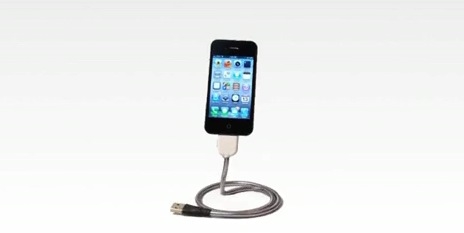
Figure 3-9 Une Bobine was a beautifully designed iPhone stand and connector that really got us excited.
These were created using iMovie and use a combination of the built-in trailer templates and some hand-drawn stick-figure animation—all done on an iPad—to tell a story that was compelling and humorous. That’s one way to get the attention of a blogger!
While the creator of Une Bobine initially had no samples that he could provide for a review, Steve was intrigued enough by the design and amused enough by the videos that he featured them on a weekly video podcast for TUAW. Although the product had already reached its funding goals, that the extra bit of publicity helped Une Bobine gain even more backers.
Common Hardware Product Categories
This section walks through some of the more common product categories for hardware and accessories and provides some tips on what features you might want to focus on when pinging your favorite bloggers to write a review or highlight post.
Cases
To really get a blogger’s attention and actually get him to write a decent review, an iPad, iPhone, or Mac case must have an outstanding design feature. This is perhaps the most overloaded category in the Apple accessory world, and there are so many similar cases out there that it’s easy to ignore your pitch. Want to see just a part of the pile of iPad and iPhone cases Steve has on hand for review while writing this book? Check out Figure 3-10.
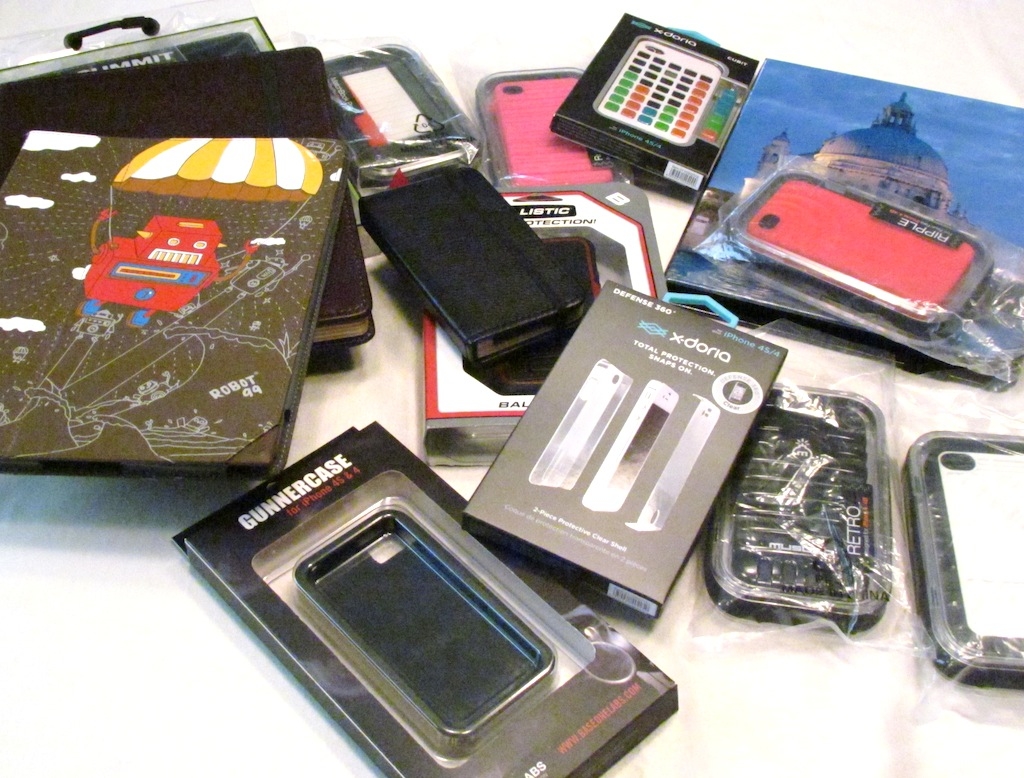
Figure 3-10 That’s a lot of cases.
To make an impact, show pictures of what makes your product stand out in the crowd or give details about a different functionality that no one else has. Otherwise, a blogger’s finger will quickly move to the Delete button.
Some examples of cases that have recently caught Steve’s attention include an iPad case that is imprinted with your own photography, an iPad backpack (the iBackFlip Somersault) that turns into a support for using the tablet while standing up, and a series of whimsically designed iPhone cases that each feature a unique texture design on the outside of the case.
Headphones/Earphones
As noted earlier, this is a place where a lot of review results are completely subjective and depend on the reviewer’s hearing and emotional response to music. We get a lot of me-too products in this area, so functionality differences are what bloggers want to hear about.
Steve enjoyed reviewing CordCruncher, which is a set of earbuds that use a unique sleeve over the cables to keep them from tangling (see Figure 3-11). In terms of sound quality, the noise-cancelling headphones from Able Planet are totally beyond anything Steve’s used before, so they were a pleasure to review. A Kickstarter project for a pair of earbuds that also allow you to hear ambient noises and avoid getting hit by a car (AIRBudz) definitely got our attention.

Figure 3-11 The CordCruncher keeps cables from tangling.
Docks
In this category, it’s all about design and integration with devices. An attractive design, however, can only make up so much ground if the dock is poorly integrated with the target device.
As an example, some docks come with apps which, once installed, provide full control of the dock. This can be useful when using the dock as an alarm clock, using it to provide a musical or sound interlude before sleep, or controlling a built-in FM radio. Watch the design, too. Steve recently reviewed a Tick Tock Dock alarm dock with a time display that was completely obscured by the docked device (see Figure 3-12). Needless to say, that had Steve scratching his head for a while, wondering what the designers were thinking.
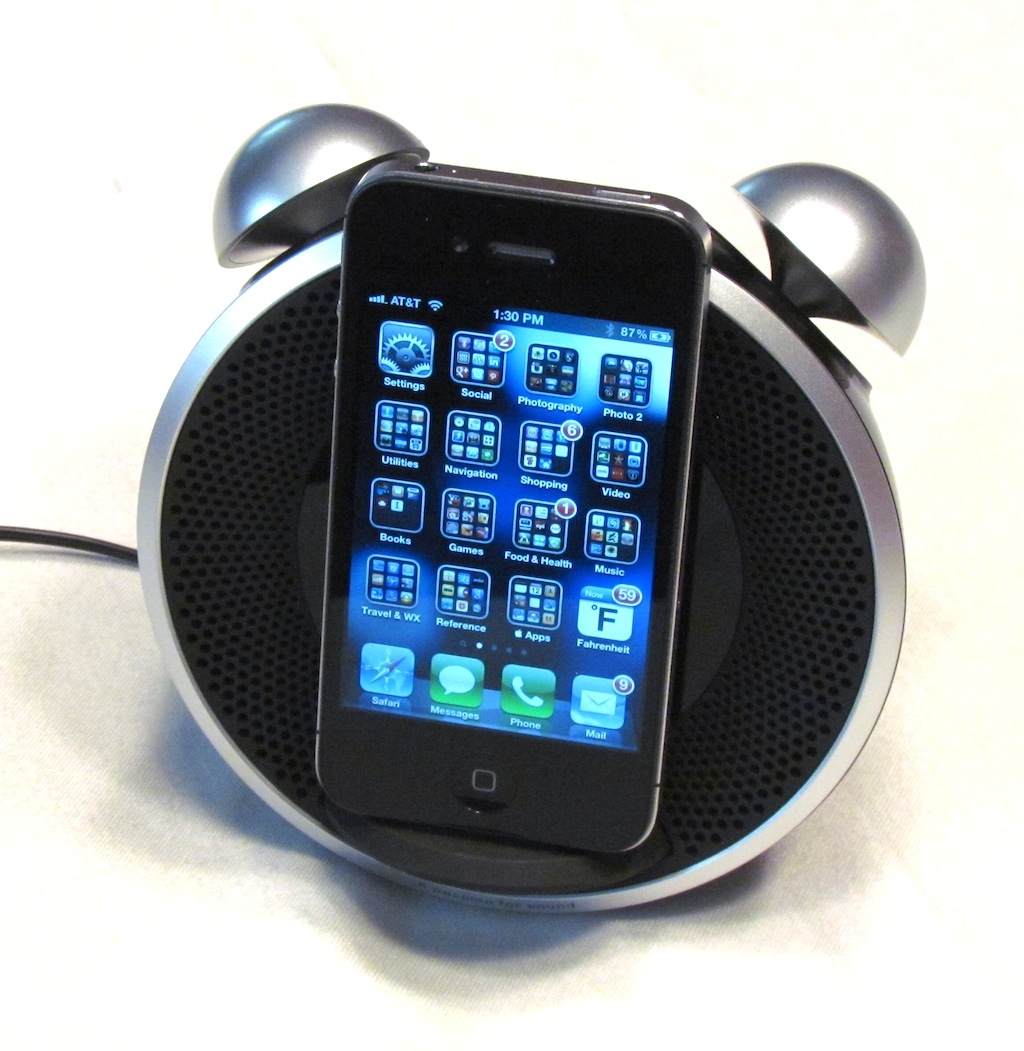
Figure 3-12 When the iPhone is inserted, as designed, it hides the clock display. What were those designers thinking?
Speakers
Bluetooth speakers are a popular hardware accessory category. Things to point out to possible reviewers include battery life, ease of charging, ability to withstand impact or splashes, and overall volume. Make sure that your product requires little or no time to pair with a handheld device, and you’ll make me—and your customers—happy.
You’d think that there’s not a lot you could do with the design of a Bluetooth speaker, and you’d be wrong. Design is, once again, a product differentiator in this category, and an attractive design gets our attention much faster than a plain grey box. On TUAW, we’ve recently reviewed Bluetooth speakers that attach to a bicycle or helmet, and devices that convert any speakers for Bluetooth readiness.
Drives
In a world where most hard drives are manufactured by the same handful of companies, it all boils down to design and functionality. External drives that complement the equipment they’re designed to work with are going to be attention-getters, and size and speed are always considerations to look at for mobile equipment. Consider the Iomega eGo Helium, as shown in Figure 3-13. It’s small, lightweight, and offers a huge capacity for storage.
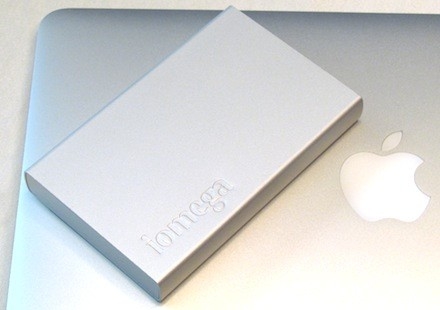
Figure 3-13 The Iomega eGo Helium offers portable storage
Remember that reviewers are not always going to have the latest computers available for testing (at least not at our blog, where we provide our own equipment), so when a new interface like Thunderbolt becomes available, it may be difficult for you to get reviews. In cases like this, consider doing side-by-side video comparisons showing just how fast the new devices are so that you can impress the blogger without having to send him a loaner computer for testing.
In fact, Steve had to recently send off a drive to Erica for testing. She was already using a new 2012 Mac mini, complete with USB 3 ports, while he had to wait for his new iMac to ship.
Power Supplies (Batteries, Chargers, Car Chargers)
Another popular accessory category has grown up around the need for our devices to outlive the limited battery capacity they’re designed with. Whether it’s an external battery pack, a charger that connects to a wall outlet, a solar charger like the Eton Mobius (see Figure 3-14), or a dual-outlet adapter for a car, power supplies are something that people need.
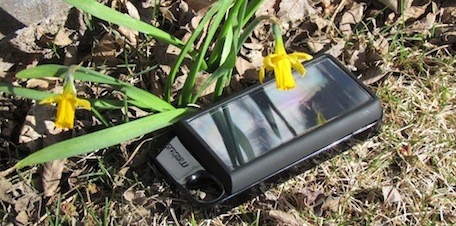
Figure 3-14 People love solar chargers for emergency power, especially during disaster situations, like Hurricane Sande, we mean, Hurricane Sandy, which hit the Eastern U.S. in late 2012.
It’s easy for manufacturers to toss out carbon-copy equipment that won’t attract the attention of bloggers. What are we looking for? Alternative energy sources, like solar panels or fuel cells, devices that use less energy while charging devices faster, or multitaskers, like a combo spare battery/data sync cable/SD card reader.
As with all the other hardware and accessory categories listed here, give bloggers the special features up front to catch their attention.
Camera Accessories
The excellent cameras in our handheld devices have become the source of another category of accessories. These come in different flavors: accessory lenses that change the field of view (like the Photojojo lens pictured in Figure 3-15, stands to help hold the phone or tablet in place for better photographs) and devices that make it easier to take photos, like “big buttons” or camera remotes.
Bloggers want to see the end result of your product, so here’s a situation where a review device can really help out. Don’t send one unannounced, however; make sure that the blogger is interested first. This is another area where a product video can get the point across to a blogger, showing how the device works to improve “iPhoneography” or make it easier to take good pictures.
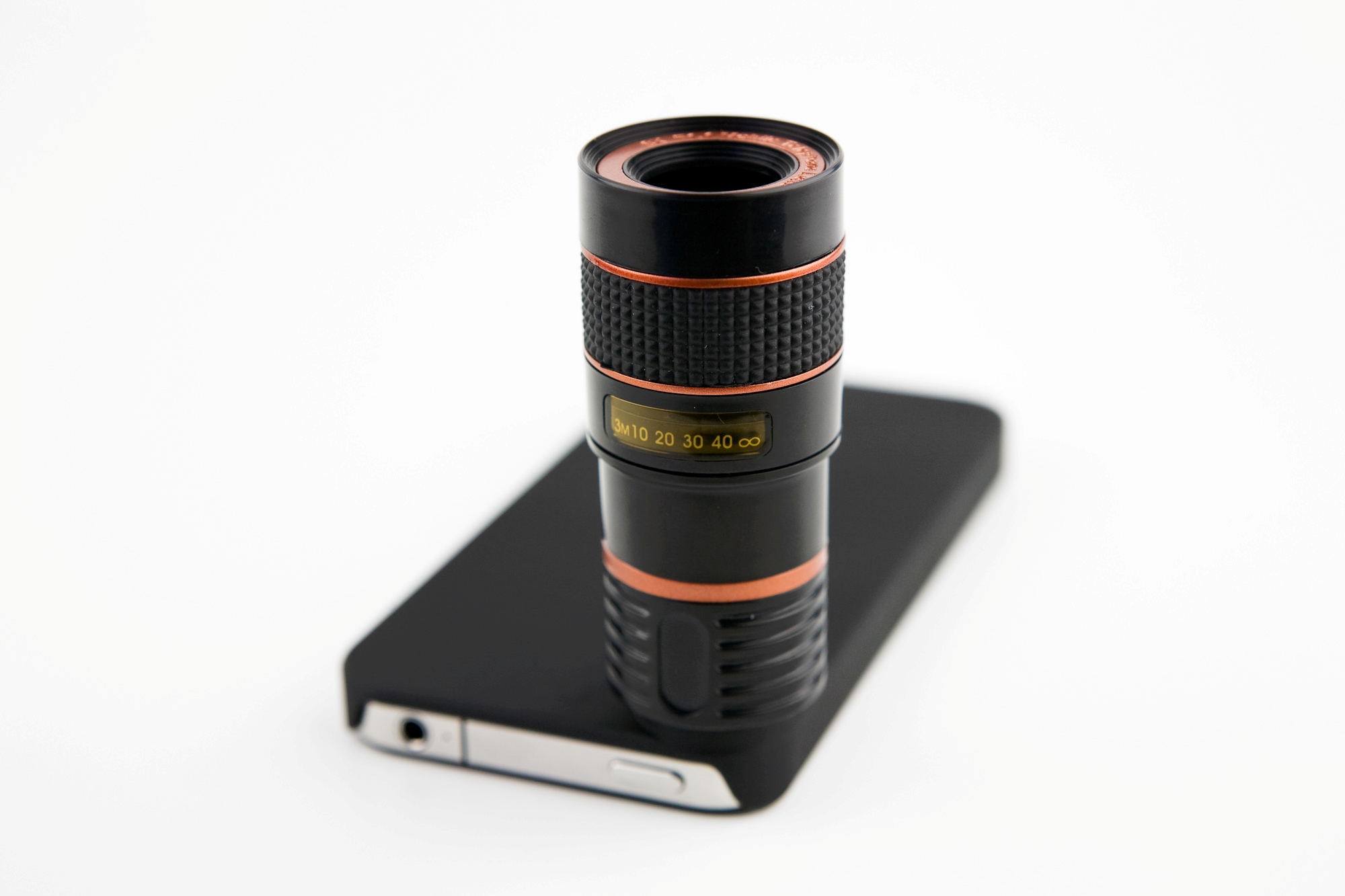
Figure 3-15 iPhoneography, as we call it, is a big review area for us.
Books/Ebooks
If you’re pitching a book or ebook to a blogger, know your audience. We often receive emails from publishers who send out review requests for books that have nothing to do with our blog’s focus. We’re unlikely to write about making Lego weapons when we’re focused on the Apple market (see Figure 3-16).
Likewise, it is foolish for a publisher to pitch a book on iOS development to an Android site, yet according to my compatriots at a few Android-centric blogs, they frequently receive this type of pitch. Think before you send!
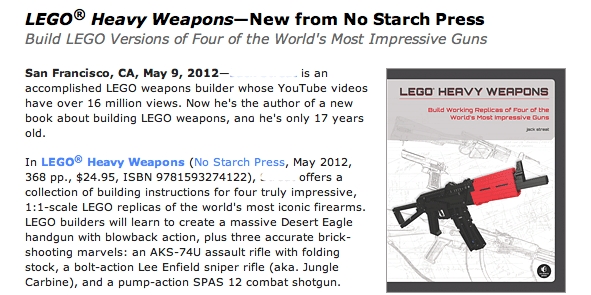
Figure 3-16 Books may, or may not, be appropriate for blog reviews. Erica regularly covers books on Mac/iOS development and general use on her TUAW Bookshelf write-ups.
Cables and Gizmos
Even an item as mundane as a cable or a cord wrap can be worth writing about, provided that it shows design or function that’s out of the ordinary. Take, for example, the first pitch we received from crowdsourced design firm Quirky. It was for the PowerCurl, a cord wrap that fits around the power adapter for Apple’s MacBook line of notebook computers.
The pitch included a photo of the brightly colored PowerCurl (see Figure 3-17), a list of the benefits of the device, and a description of how Quirky works to design and perfect different consumer products. The PowerCurl was insanely simple, yet something no one else had ever created. We not only wrote a review of the device, but Steve bought one for personal use and has also become a Quirky participant.
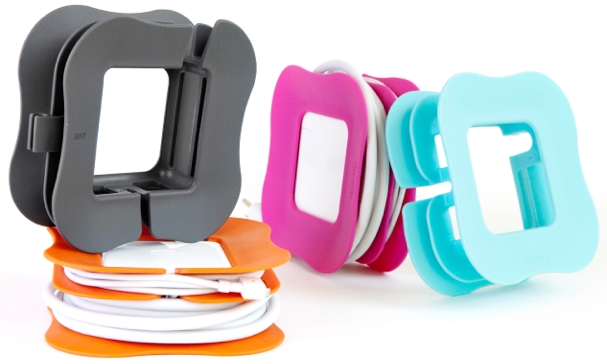
Figure 3-17 The PowerCurl combined utility with beautiful design.
Likewise, a product that fits a niche can excite a blogger. A recent case in point is the Kanex ATV Pro, a dongle that makes the missing connection between an Apple TV box and a PC projector. The Apple TV uses HDMI for a connection to an HDTV, so it can’t be used out of the box with the vast majority of projectors.
Kanex created a box that connects to the Apple TV on one end, and has a standard VGA connector on the other end to hook up to the projector. The result? Anyone can now use AirPlay to beam presentations from an iOS device to a projector.
It’s something that was so obvious that a lot of bloggers wondered why no one had stepped up to the plate and delivered the product. It really got the attention of several bloggers at TUAW, who give presentations on a regular basis.
Hardware Pitches
Pitching hardware or an accessory to a blogger takes as much skill as trying to get a writer interested in an app. In some cases, it can be even more difficult because of the commodity nature of accessories, like smartphone cases.
When you’re writing a pitch for hardware or accessories, remember that a blogger wants to see what’s new or different about your product in terms of design, functionality, and value. Sending out a generic release about another iPhone case that looks just like a thousand other cases won’t result in a blog post. As in the case of creating an app, your product’s ultimate success should be in mind before you start designing it.
Because a good part of your marketing depends on the kindness of bloggers, don’t do yourself a disfavor by trying to sell a crappy product. Create something new, different, and good, and the world will beat a path to your door, after they’ve read about you on a blog.
Wrapping Up
This chapter showed you the ins and outs of creating pitches, from subject line to description to product details. Before you move to the next chapter, here are a few final points to ponder:
Proofread your work before you send out your pitch. A big typo in your subject line (e.g., “Dropboc unveils new iOS experience!”) is the spinach-on-your-teeth of the blogging world.
Less is more. Spend time trimming your pitches down to the basics. You want to excite and inform, but not overwhelm.
Don’t forget the video. It doesn’t have to be polished or perfect; it just has to showcase your product.
Motivate, motivate, motivate. Whether you are writing a pitch or your marketing text, your hook is your product’s heart. Unless you explain why people should care, they won’t.